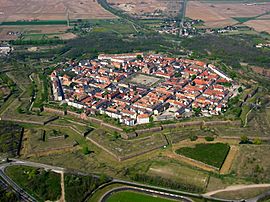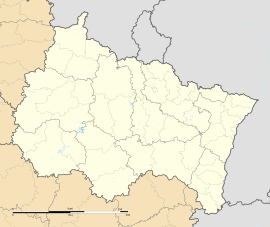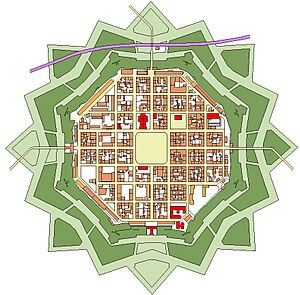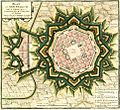Neuf-Brisach facts for kids
Quick facts for kids
Neuf-Brisach
|
||
|---|---|---|

An aerial photograph showing the layout of the town and the way it was built as a fortification.
|
||
|
||
| Country | France | |
| Region | Grand Est | |
| Department | Haut-Rhin | |
| Arrondissement | Colmar-Ribeauvillé | |
| Canton | Ensisheim | |
| Area
1
|
1.33 km2 (0.51 sq mi) | |
| Population
(2021)
|
1,947 | |
| • Density | 1,464/km2 (3,792/sq mi) | |
| Time zone | UTC+01:00 (CET) | |
| • Summer (DST) | UTC+02:00 (CEST) | |
| INSEE/Postal code |
68231 /68600
|
|
| Elevation | 194–198 m (636–650 ft) (avg. 197 m or 646 ft) |
|
| 1 French Land Register data, which excludes lakes, ponds, glaciers > 1 km2 (0.386 sq mi or 247 acres) and river estuaries. | ||
Neuf-Brisach is a special fortified town in the Haut-Rhin department of French Alsace. It was built to protect the border between France and the German states. Its name means New Breisach, because France lost the old town of Breisach in 1697.
Today, Neuf-Brisach is a UNESCO World Heritage Site. This means it's recognized globally for its amazing military design. It shows how much the famous engineer Vauban influenced military buildings from the 17th to 19th centuries.
Contents
History of Neuf-Brisach
Work on this fortified town started in 1698. The plans were drawn by Vauban, a brilliant military engineer who worked for King Louis XIV. Vauban passed away in 1707, and another engineer, Louis de Cormontaigne, finished his last project.
Town Design: An Ideal City
The city's layout was like an "ideal city," which was a popular idea back then. It had a neat, square grid of streets inside an eight-sided (octagonal) fort. A large central square took up four city blocks in the middle, with an impressive church nearby.
There were also areas for private homes, some with gardens. Simpler homes were built in long blocks along the inner walls. This also helped protect the nicer houses from cannon fire. Large gates in the main walls allowed people to enter and exit the town.
Vauban's Fortifications: A Strong Defense
The fortifications of Neuf-Brisach were Vauban's final and most advanced work. They had two main lines of defense. The inner line was a strong wall around the city. The outer line was a system of star-shaped earthworks (mounds of earth).
The main wall was mostly octagonal. Each corner had a raised, five-sided tower that stuck out, making them the highest points of the defense system. The outer earthworks were very deep and covered more land than the city itself. These layers of defense made the town very hard to attack.
Neuf-Brisach in Modern Times
The city was damaged during World War II, but it still shows a very clear example of early 18th-century fortifications. During the war, Germany occupied the town.
In 2008, Neuf-Brisach was officially named a UNESCO World Heritage Site. It is part of a larger group called the Fortifications of Vauban, which includes many of his amazing designs.
Important People
- François-Joseph Offenstein (1760–1837): He was the main commander of the town during the French Revolutionary Wars.
- Louis Schlaefli (born 1938): A librarian.
- Vauban (1633–1707): The military engineer who designed the city's strong defenses.
Gallery
-
The moats and fortifications designed by Vauban
See also
 In Spanish: Neuf-Brisach para niños
In Spanish: Neuf-Brisach para niños







